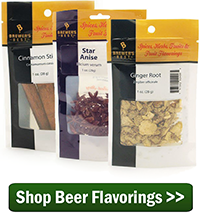 Belgium has one of the oldest, most diverse, and vibrant beer cultures in the world, from the centuries-old Trappist breweries housed in monasteries to the multitude of artisanal farmhouse breweries littered throughout the countryside. There is a lot of history when it comes to Belgian beer styles.
Belgium has one of the oldest, most diverse, and vibrant beer cultures in the world, from the centuries-old Trappist breweries housed in monasteries to the multitude of artisanal farmhouse breweries littered throughout the countryside. There is a lot of history when it comes to Belgian beer styles.
It would take a very big book to list all of the varieties of beer made in Belgium, so for the purposes of this blog post, I will list some of the styles that are most iconic of the country and the ones you will most commonly find when home brewing Belgian style beers.
- Belgian Pale Ale – A Belgian pale ale looks very similar to it’s American cousin, but the flavor profile is all its own. For one, Belgian pale ale is lower on the IBU scale and more malt focused. Pale malts form the base of the grain bill, with some medium-colored malts like Vienna, Munich, Biscuit, and Aromatic malt providing some color and complexity. Adjunct sugars may be used to increase gravity, add flavor, and impart a dry finish. Spices may be used for additional complexity, but Belgian yeast provides the signature fruity and spicy flavors that define this style.
- Belgian Abbey-Style Beers (Singel, Dubbel, Tripel) – Abbey-style beers are made in the style of those crafted by the Trappist breweries, six of which are located in Belgium. These abbey beers are segregated by alcoholic strength and characterized by a range of malt flavors that may be described as toast, raisins, or dates. They may have a sweet, rum-like flavor from the use of Belgian candi sugar. An Abbey-style Belgian ale yeast provides dominant fruity and aromatic flavors. A singel may be low to moderate strength and golden in color,
 with a dubbel often darker and closer to 7% ABV. Belgian tripel tends to be golden, dry, herbal or floral, and 7.5-10% ABV. Consider making this Westmalle Tripel clone recipe. It’s a great place to start when home brewing Belgian beer styles.
with a dubbel often darker and closer to 7% ABV. Belgian tripel tends to be golden, dry, herbal or floral, and 7.5-10% ABV. Consider making this Westmalle Tripel clone recipe. It’s a great place to start when home brewing Belgian beer styles.
- Belgian Witbier – Made popular among modern drinkers by the likes of Hoegaarden and Blue Moon, Belgian wit is one of the most well-known styles of Belgian beer. Witbier, or “white beer”, is very pale in color (2-4 SRM), cloudy, and somewhat sweet with a high proportion of unmalted wheat. Orange peel and spice may contribute a refreshing, fruity complexity, but should not dominate the flavor profile. A Belgian wheat yeast strain will provide the appropriate phenolics and esters for this style.
- Saison – Saison is style of beer from the French-speaking part of Belgium. It’s a moderate strength pale ale brewed with a little more hops than a Belgian pale, often including adjunct grains like wheat, adjunct sugar such as cane sugar, and spices, especially coriander, orange peel, or a mix of “mystery spices”. Saison Dupont is considered one of the classics.
- Lambic – Lambic is a type of sour ale that should only be attempted by seasoned homebrewers. It’s characterized by a dry, acidic taste and a range of complex flavors that may be smokey or earthy. A true lambic requires a culture of wild bacteria and yeast and aging of a year or longer to achieve the appropriate flavor profile. Young and old lambic may be blended to produce gueuze, while fruit lambic may be aged on raspberries or cherries.

You will likely see a number of Belgian beer styles beyond those listed above – remember this is just a quick guide to Belgian beer styles – including a mashup of other common styles: Belgian stout, Belgian IPA, Belgian amber, Belgian holiday beers, Belgian specialty beers. The list above is only the common ones you will run across when home brewing Belgian style beers.
What are some of your favorite Belgian beer styles to brew?
—–
David Ackley is a beer writer, brewer, and self-described “craft beer crusader.” He holds a General Certificate in Brewing from the Institute of Brewing and Distilling and is founder and editor of the Local Beer Blog.
